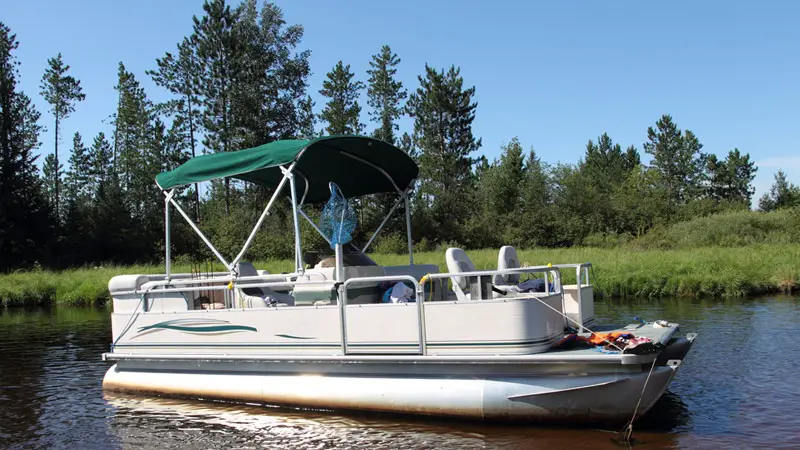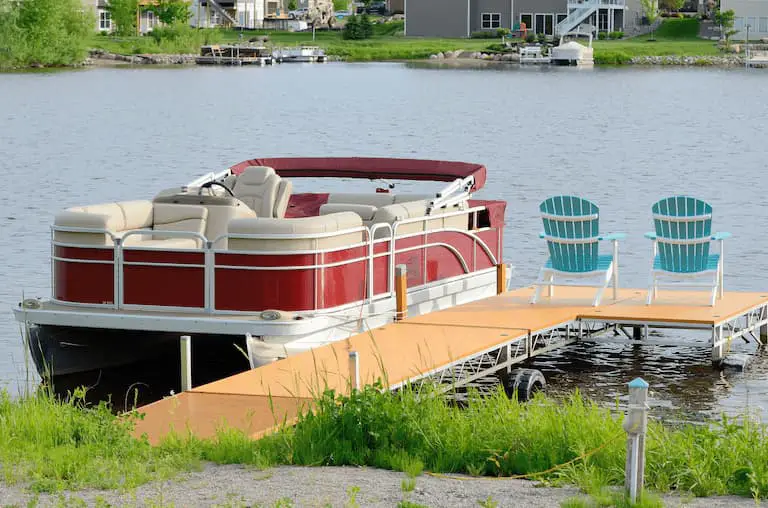Pontoon Boat with Inboard Motor (Exploring the Pros & Cons of Pontoons with Inboard Engine )
If you’re in the market for a pontoon boat, you may be wondering whether to opt for an inboard or outboard motor. While outboard motors are commonly seen on pontoon boats, inboard motors have become popular among boaters. However, deciding between an inboard and an outboard motor can be tough.
Some manufacturers do make pontoon boats with inboard motors, although they are not especially common or in demand from buyers. Both inboard and outboard motors have pros and cons, and the choice depends on personal preference and intended use.
On the one hand, inboard motors can offer more power and torque, benefiting those who enjoy water sports like wakeboarding or tubing. On the other hand, outboard motors are often less expensive and easier to maintain, making them a popular choice among budget-conscious boaters. This article will explore the pros and cons of pontoon boats with inboard motors, so you can decide when choosing your next boat.
Inboard vs. Outboard Motors: What’s the Difference?

Inboard and outboard motors are the two main propulsion systems used on boats, including pontoon boats. The key difference between these two engine types is their location on the boat.
Outboard motors are mounted on the boat’s transom or back and are easily accessible for maintenance and repair. On the other hand, inboard motors are located inside the boat’s hull, typically in the rear or middle of the vessel. Inboard motors are more difficult to access for maintenance and repair, but they offer more power and torque than outboard motors.
Another difference between in and outboard motors is how they steer the boat. Outboard motors have a swiveling steering system that allows the operator to control the boat’s direction. On the other hand, inboard motors rely on a rudder attached to the boat’s stern to steer the vessel.
When it comes to pontoon boats, outboard motors are more common because they are generally less expensive and easier to maintain. However, inboard motors are becoming increasingly popular among pontoon boat owners who prioritize power and torque for water sports and other activities.
The Pros of Pontoon Boats with Inboard Motors (Versus Outboard Motor)
Pontoon boats with inboard motors offer a variety of advantages over those with outboard motors. Here are some of the main pros of choosing a pontoon boat with an inboard motor:
- Increased Power and Torque: Inboard motors generally offer more boat power and torque than outboard motors, making them a great option for pontoon boats that will be used for water sports like wakeboarding, tubing, and skiing.
- Smooth and Quiet Operation: Inboard motors are typically much quieter and smoother than outboard engines, making for a more enjoyable and relaxing boating experience.
- More Interior Space: Inboard motors are located inside the boat’s hull, so they don’t take up any valuable space on the back of the boat. This can give pontoon boat owners more interior space for seating, storage, and other amenities.
- Better Fuel Economy: Inboard motors are generally more fuel-efficient than outboard motors, saving pontoon boat owners money in the long run.
- Reduced Maintenance: Compared to outboard motors, inboard motors demand less maintenance because they are less vulnerable to environmental factors and usually equipped with stronger parts.
Pontoon boats with inboard motors are great for boaters prioritizing power, torque, and a smooth, quiet ride. While they may be more expensive and require more maintenance than outboard motors, their benefits can be worth the investment.
The Cons of Pontoon Boats with Inboard Motors vs Outboard Engines

While there are many advantages to choosing a pontoon boat with an inboard motor, there are also some potential downsides. Here are some of the main cons of pontoon boats with inboard motors:
- Higher Cost: Inboard motors are generally more expensive than outboard motors, making pontoon boats with inboard motors more costly.
- More Difficult Maintenance and Repair: Inboard motors are located inside the boat’s hull, making them more difficult to access for maintenance and repair. This can increase the cost and time required for these tasks.
- Reduced Maneuverability: Inboard motors rely on a rudder to steer the boat, which can reduce maneuverability compared to outboard motors. This can be particularly noticeable in tight spaces or when navigating shallow water.
- Reduced Speed: While inboard motors offer more power and torque than outboard motors, they may not be able to achieve the same top speed as an outboard motor of similar horsepower.
- Limited Installation Options: Not all pontoon boats are designed to accommodate inboard motors, limiting your options for choosing a boat and motor.
While these cons may not be dealbreakers for all boaters, they are important factors when choosing a pontoon boat with an inboard or outboard motor. Ultimately, the choice depends on personal preference and intended use.
Maintenance and Repair Considerations
Maintenance and repair considerations are important for a pontoon boat with an inboard motor. Here are some key things to keep in mind:
- Regular Maintenance: Inboard motors require regular maintenance to keep them running smoothly. This includes oil changes, fuel filter changes, and impeller replacements. Follow the manufacturer’s recommended maintenance schedule to keep your motor in good condition.
- Accessibility: Inboard motors can be more difficult to access for maintenance and repair than outboard motors, as they are inside the boat’s hull. Consider the design of your pontoon boat and the accessibility of the motor when choosing an inboard motor.
- Winterization: Inboard motors require proper winterization to prevent damage from freezing temperatures. This includes draining the cooling system, adding antifreeze, and storing the boat in a dry, protected location.
- Repair Costs: Inboard motors can be more expensive than outboard motors, requiring specialized knowledge and tools. Consider the potential repair costs when choosing an inboard motor.
- Warranty and Service: Be sure to choose an inboard motor from a reputable manufacturer with a strong warranty and service network. This can help ensure you have access to the support you need if something goes wrong.
While inboard motors can offer many benefits, they require proper maintenance and care to keep them running smoothly. Consider the potential maintenance and repair costs when choosing an inboard motor for your pontoon boat.
Pricing and Budgeting for Inboard Motors

Pricing and budgeting for inboard motors are important considerations when choosing a pontoon boat. Here are some key things to keep in mind:
- Upfront Cost: Inboard motors are generally more expensive than outboard motors, so be prepared to pay a higher upfront cost when choosing an inboard motor for your pontoon boat.
- Installation Costs: Inboard motors may also have higher installation costs, requiring more specialized knowledge and installation tools. Be sure to factor in these costs when budgeting for your new motor.
- Fuel Costs: While inboard motors are generally more fuel-efficient than outboard motors, they may require more expensive fuel. Be sure to research the fuel requirements for your chosen inboard motor and factor in the potential fuel costs when budgeting for your boat.
- Maintenance and Repair Costs: As mentioned earlier, inboard motors may require more expensive maintenance and repair costs than outboard motors. Be sure to factor in these costs when budgeting for your new motor.
- Resale Value: Inboard motors may have a higher resale value than outboard motors, which can help offset some of the higher upfront costs. Consider the potential resale value of your chosen inboard motor when making your budget.
Pricing and budgeting for inboard motors require careful consideration of all potential costs, including upfront costs, installation costs, fuel costs, maintenance and repair costs, and resale value. Be sure to research and choose an inboard motor that fits your budget and meets your needs for power and performance.
Inboard Motors for Water Sports and Other Activities
Inboard motors are popular for pontoon boats for water sports and other activities. Here are some of the reasons why:
- Power and Torque: Inboard motors offer more power and torque than outboard motors, making them a great option for water sports like wakeboarding, tubing, and skiing.
- Smooth and Quiet Operation: Inboard motors are typically much quieter and smoother than outboard motors, which can make for a more enjoyable and comfortable experience when participating in water sports.
- More Interior Space: Inboard motors are located inside the boat’s hull, so they don’t take up valuable space on the back of the boat. This can give pontoon boat owners more interior space for seating, storage, and other amenities.
- Better Propulsion: Inboard motors provide better propulsion in rough water conditions, which can be particularly beneficial for water sports like wakeboarding and tubing.
- Reduced Risk of Injury: Inboard motors are located inside the boat’s hull, which reduces the risk of injury from propeller strikes.
Inboard motors are great for pontoon boats for water sports and other activities requiring power and torque. While they may be more expensive and require more maintenance than outboard motors, their benefits can be well worth the investment for those who enjoy water sports and other activities on the water.
Choosing the Right Option for You: Factors to Consider
When choosing between an inboard or an outboard motor for your pontoon boat, there are several factors to consider. Here are some of the most important:
- Intended Use: Consider what you’ll be using your pontoon boat for. An inboard motor may be the better choice if you plan to use it for water sports. An outboard motor may be a better option if you use it primarily for cruising and leisure activities.
- Budget: Inboard motors are generally more expensive than outboard motors, so consider your budget and whether you can afford the higher upfront costs.
- Maintenance and Repair: Inboard motors may require more maintenance and repair than outboard motors, so consider the potential costs of these tasks.
- Maneuverability: Outboard motors provide better maneuverability than inboard motors, which can be particularly important in tight spaces or when navigating shallow water.
- Interior Space: Inboard motors take up less space on the back of the boat, which can provide more interior space for seating, storage, and other amenities.
- Noise and Vibration: Inboard motors are typically quieter and smoother than outboard motors, which can provide a more comfortable boating experience.
- Propulsion: Inboard motors provide better propulsion in rough water conditions, which can benefit water sports and other activities.
Consider these factors when deciding between an inboard or an outboard motor for your pontoon boat. Ultimately, the right choice depends on your preferences, intended use, and budget.







